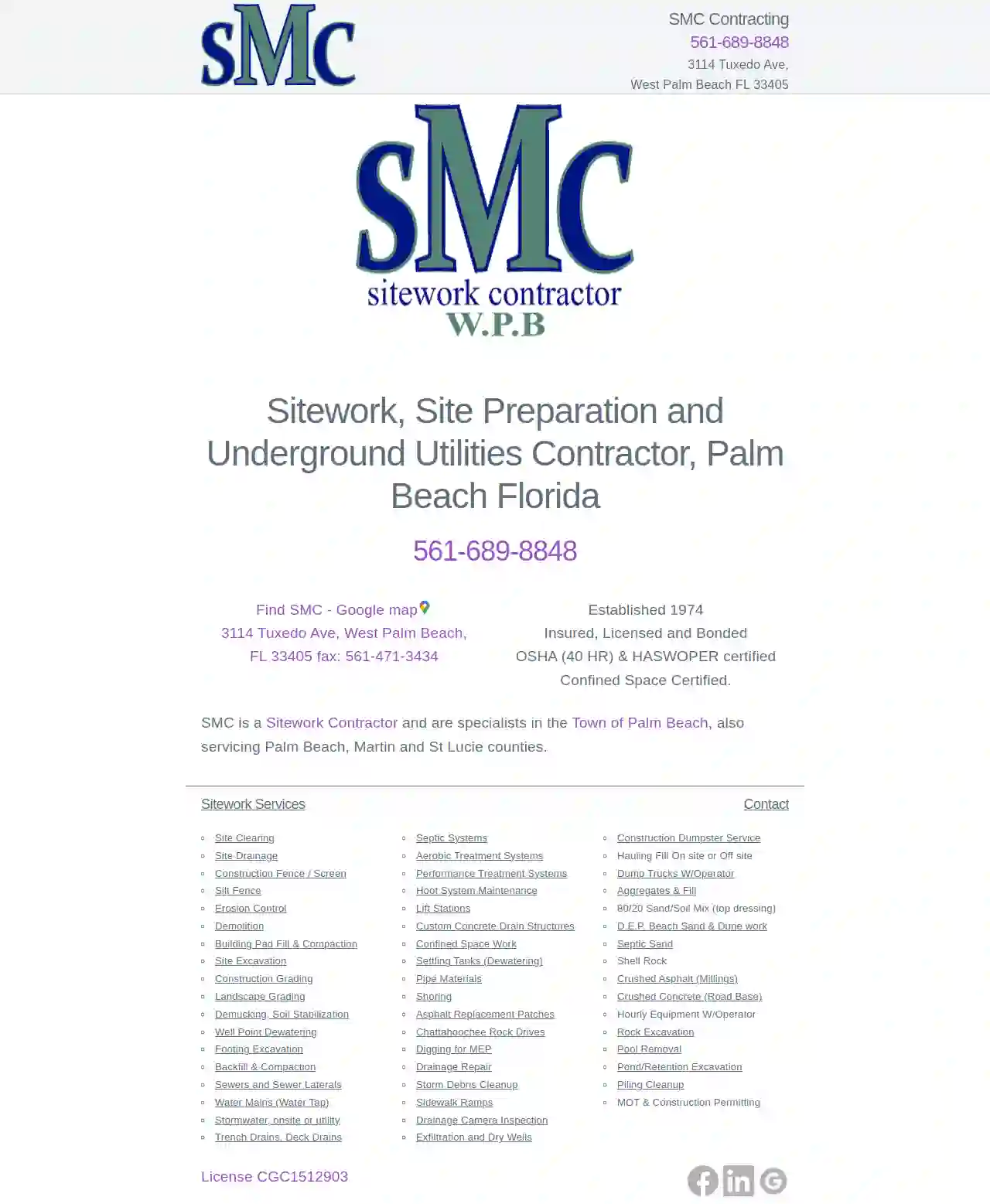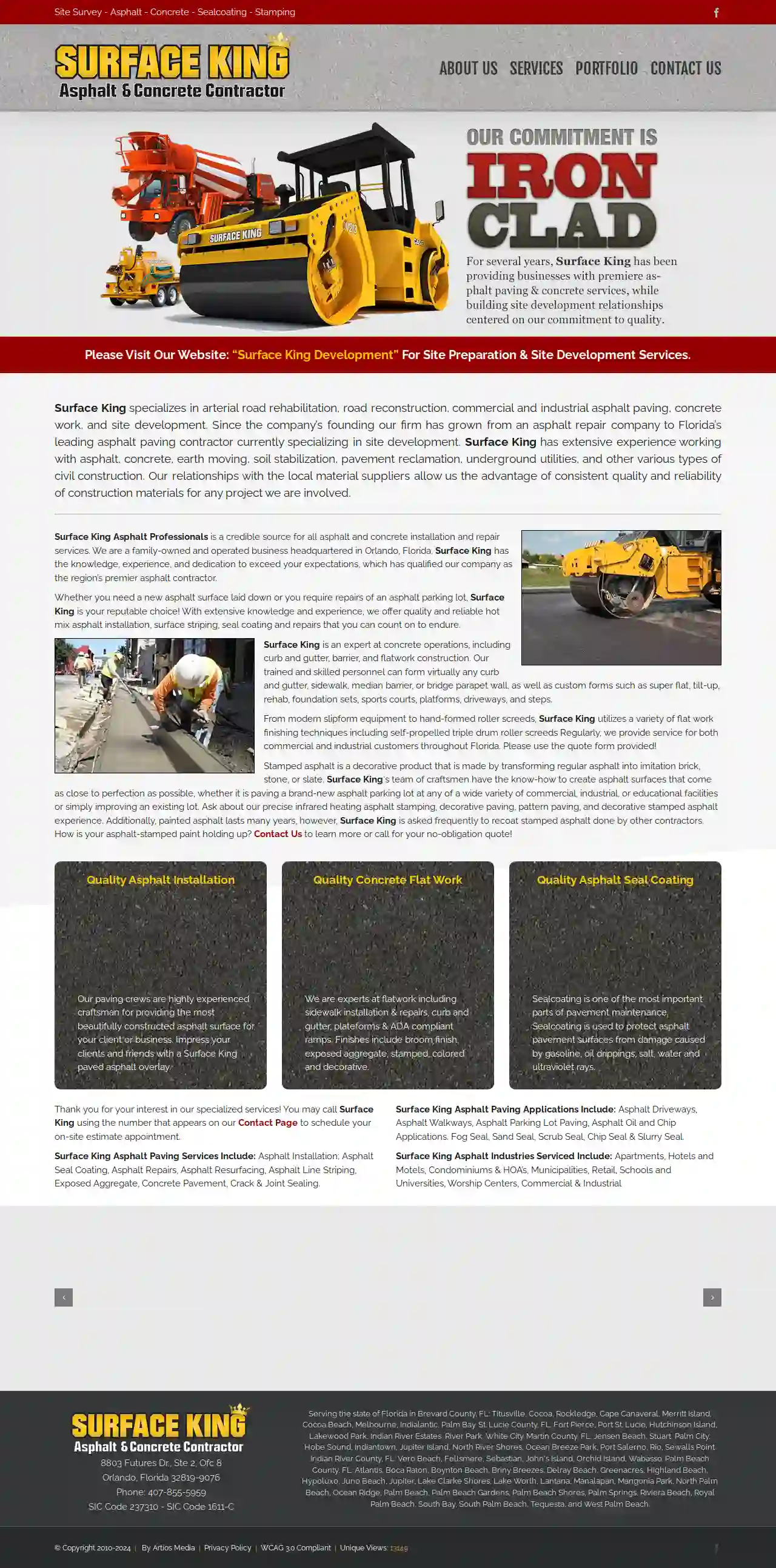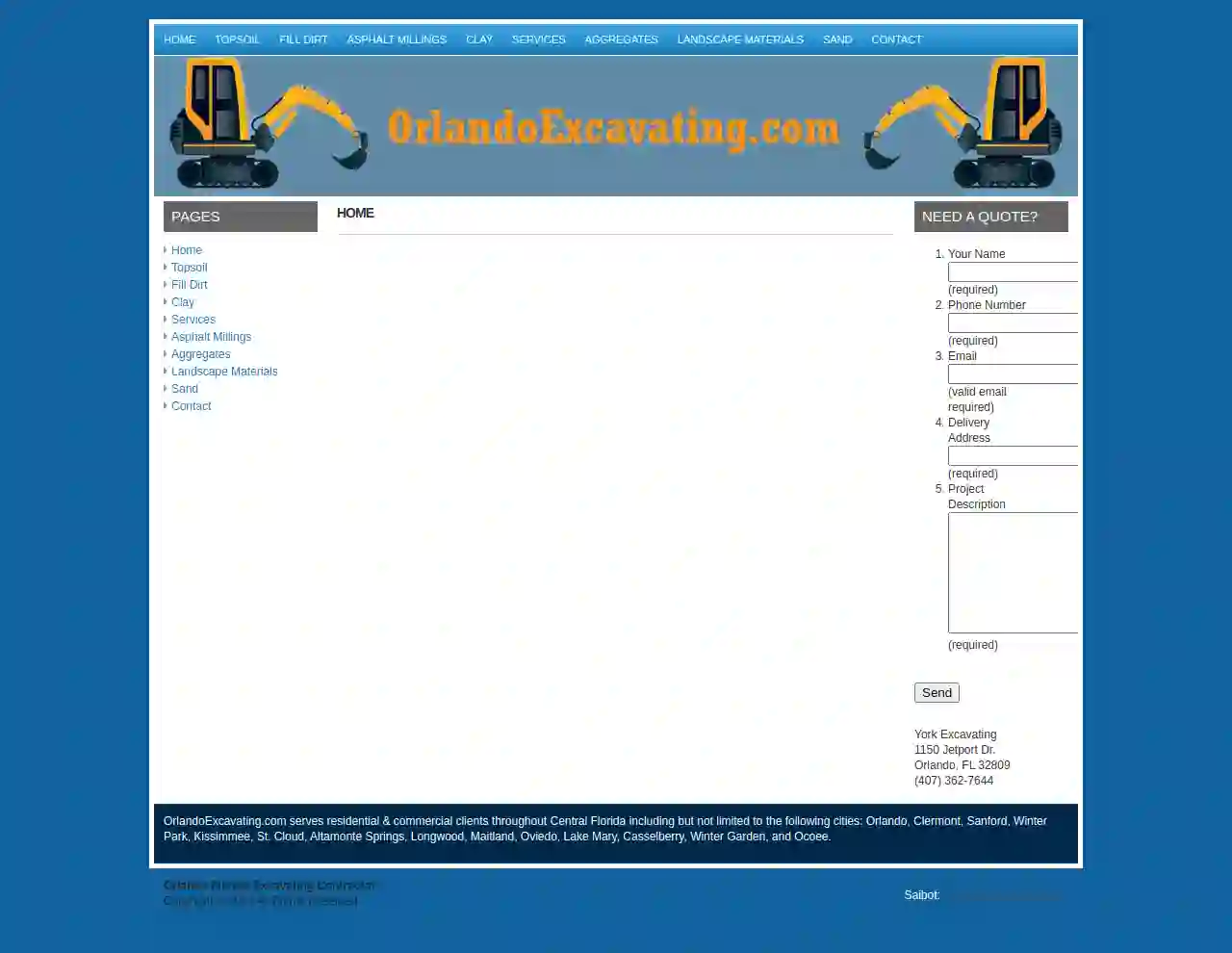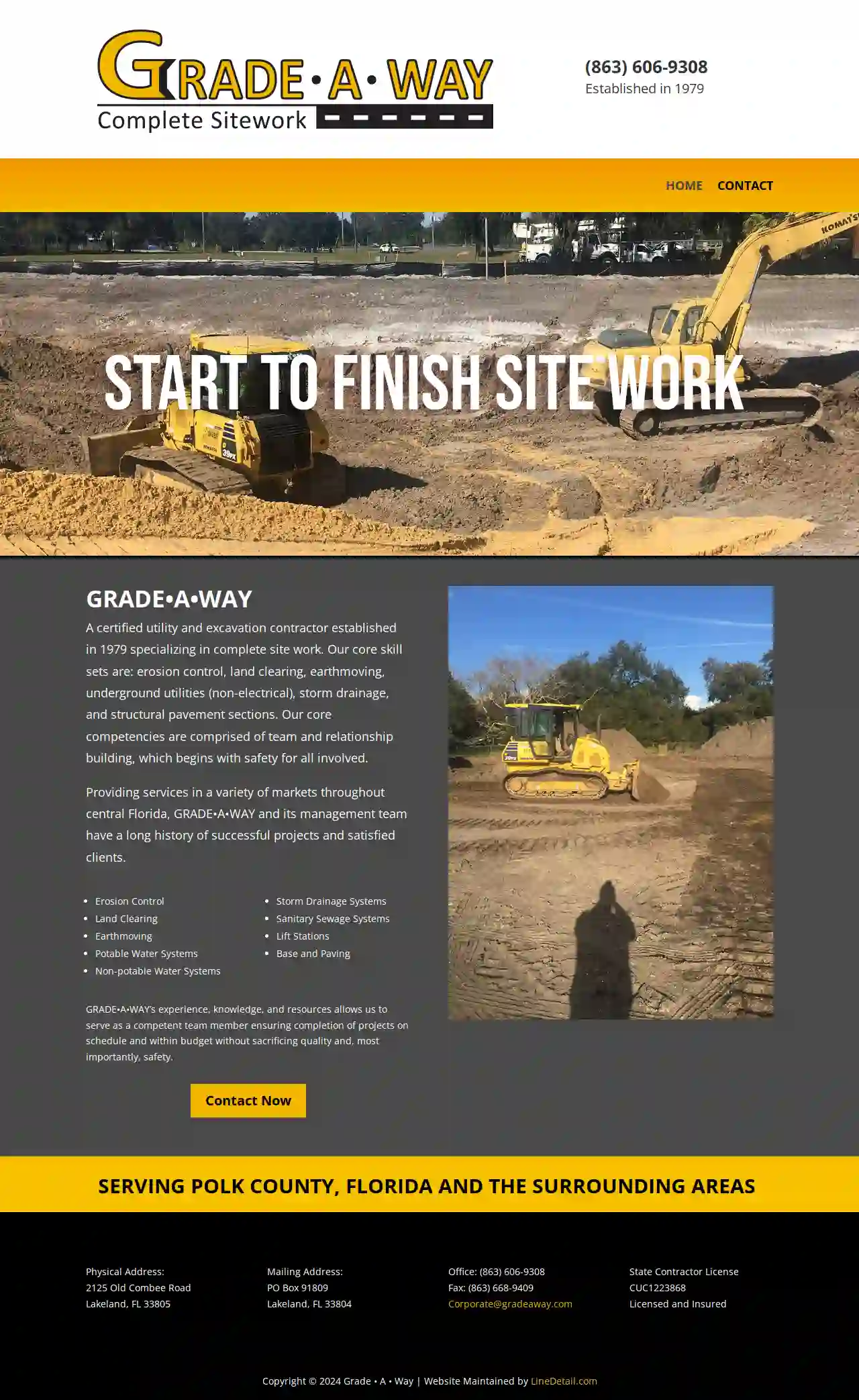Excavation Contractors Coral Springs
Best Excavation Services in Coral Springs
Receive multiple Land Excavation quotes for your project today! Compare profiles, reviews, accreditations, portfolio, etc... and choose the best offer.

SMC Contracting
4.715 reviews3114 Tuxedo Ave, West Palm Beach, 33405, USSMC Contracting: Your Trusted Sitework Partner in Palm Beach County Established in 1974, SMC Contracting has been a leading provider of sitework, site preparation, and underground utility services in Palm Beach County, Florida. We are a family-owned and operated business with a commitment to quality, safety, and customer satisfaction. Our team of experienced professionals is dedicated to delivering exceptional results on every project, no matter the size or complexity. We take pride in our reputation for reliability, efficiency, and attention to detail. We are fully insured, licensed, and bonded, and we are committed to adhering to the highest industry standards. Our commitment to safety is evident in our OSHA (40 HR) & HASWOPER certifications, as well as our Confined Space Certification. SMC Contracting specializes in serving the Town of Palm Beach, but we also proudly serve Palm Beach, Martin, and St. Lucie counties. We are your one-stop shop for all your sitework needs, from site clearing and excavation to utility installation and landscaping. Contact us today to discuss your project and learn how SMC Contracting can help you achieve your goals.
- Services
- Why Us?
- Our Team
- Gallery
Get Quote
Surface King LLC
54 reviews8803 Futures Dr., Ste 2, Ofc 8, Orlando, 32819-9076, USSurface King: Your Premier Asphalt and Concrete Contractor in Florida Surface King is a family-owned and operated business headquartered in Orlando, Florida. We specialize in arterial road rehabilitation, road reconstruction, commercial and industrial asphalt paving, concrete work, and site development. Our team of experienced professionals has the knowledge, experience, and dedication to exceed your expectations, which has qualified our company as the region’s premier asphalt contractor. Since our founding, we've grown from an asphalt repair company to Florida's leading asphalt paving contractor, specializing in site development. We have extensive experience working with asphalt, concrete, earth moving, soil stabilization, pavement reclamation, underground utilities, and other various types of civil construction. Our relationships with local material suppliers allow us the advantage of consistent quality and reliability of construction materials for any project we are involved in. Whether you need a new asphalt surface laid down or you require repairs of an asphalt parking lot, Surface King is your reputable choice! With extensive knowledge and experience, we offer quality and reliable hot mix asphalt installation, surface striping, seal coating and repairs that you can count on to endure. Surface King is an expert at concrete operations, including curb and gutter, barrier, and flatwork construction. Our trained and skilled personnel can form virtually any curb and gutter, sidewalk, median barrier, or bridge parapet wall, as well as custom forms such as super flat, tilt-up, rehab, foundation sets, sports courts, platforms, driveways, and steps. From modern slipform equipment to hand-formed roller screeds, Surface King utilizes a variety of flat work finishing techniques including self-propelled triple drum roller screeds. Regularly, we provide service for both commercial and industrial customers throughout Florida. Please use the quote form provided! Stamped asphalt is a decorative product that is made by transforming regular asphalt into imitation brick, stone, or slate. Surface King‘s team of craftsmen have the know-how to create asphalt surfaces that come as close to perfection as possible, whether it is paving a brand-new asphalt parking lot at any of a wide variety of commercial, industrial, or educational facilities or simply improving an existing lot. Ask about our precise infrared heating asphalt stamping, decorative paving, pattern paving, and decorative stamped asphalt experience. Additionally, painted asphalt lasts many years, however, Surface King is asked frequently to recoat stamped asphalt done by other contractors. How is your asphalt-stamped paint holding up? Contact Us to learn more or call for your no-obligation quote!
- Services
- Why Us?
- Gallery
Get Quote
All American Land Clearing & Tractor Services
4.820 reviewsPort Saint Lucie, USAbout Us Welcome to All American Land Clearing & Tractor Services, your premier destination for all your land clearing and tractor service needs. Based in the heart of the Treasure Coast, we proudly serve the areas spanning from Palm Bay, FL to West Palm Beach. With a strong commitment to excellence, our company is founded on the principles of customer satisfaction and affordability. Backed by extensive experience and knowledge, we deliver the highest quality service to our valued clients. No job is too big or too small – we consistently strive for greatness in every project we undertake. At All American, we prioritize a one-on-one approach with our clients, ensuring the highest quality and satisfaction at every step. Our expertise encompasses a range of services, including land clearing, earthwork, bobcat and tractor service, milling, finish grading, and more. We are also well-equipped to handle pine tree stump removal, providing comprehensive solutions for all your land enhancement needs. Experience excavation excellence with our skilled team and advanced machinery. We take pride in transforming properties and optimizing land potential through meticulous attention to detail and precision. Choose All American Land Clearing & Tractor Services for professional, reliable, and top-notch solutions that exceed expectations. Contact us today to discuss your project requirements and let us help you bring your vision to life. Take the Next Step with All American Land Clearing and Tractor Services Contact us today and let's discuss your project requirements and find the perfect solution for you.
- Services
- Why Us?
- Gallery
Get Quote
Things & Stuff LLC Tractor Excavation Land Clearing and Forestry Mulching
532 reviews2506 Timbercreek Loop E., Lakeland, 33805, USAbout Things & Stuff LLC A Lakeland, Florida native, I've been self-employed since I was about 12 years old. I started with my own neighborhood lawn business, then expanded to pallet wall and furniture building. Eventually, I moved into home repairs and rehabs. But after purchasing my first tractor, there was no turning back. I established my own LLC for my tractor, skid steer, and excavation company, becoming fully licensed and insured. I continue to add equipment to make my services more affordable (by avoiding rental costs). Recently, I've added dumpster rental and demo to my services, launching Junk That Stuff as a new division. I'm committed to continuous learning and growth in my business, ensuring I'm better equipped to serve you, my valued customer. Things & Stuff is my passion, and honesty and reliability are the cornerstones of my company. I've been working with earth moving machinery for a significant amount of time. From a young age, I've honed my skills to meet the diverse needs of my clients. As a small business, I've experienced steady growth while maintaining a personal touch, providing my customers with the attention they deserve and expect. Customer satisfaction is my top priority, and my goal is to build lasting relationships with repeat customers. "~Things & Stuff, owned and operated by Jonathan Edwards"
- Services
- Why Us?
- Our Team
- Gallery
Get Quote
Orlando Florida Excavating Contractor
2.79 reviews1150 Jetport Dr., Orlando, 32809, USOrlando Excavating is a trusted excavating contractor serving residential and commercial clients throughout Central Florida. We offer a wide range of services, including topsoil, fill dirt, asphalt millings, clay, aggregates, landscape materials, and sand. Our team of experienced professionals is dedicated to providing high-quality services at competitive prices. We are committed to safety and environmental responsibility, and we strive to exceed our clients' expectations on every project. We are proud to serve the following cities in Central Florida: Orlando, Clermont, Sanford, Winter Park, Kissimmee, St. Cloud, Altamonte Springs, Longwood, Maitland, Oviedo, Lake Mary, Casselberry, Winter Garden, and Ocoee.
- Services
- Why Us?
Get Quote
Landworx Excavating and Trucking
51 reviewsRobertsdale, AL, 36567, USAbout Landworx Excavating and Trucking Landworx Excavating and Trucking, based out of Robertsdale, Alabama, is a leading provider of excavation and trucking services in the region. With a commitment to excellence, we specialize in site preparation, land clearing, grading, and reliable material transportation for residential, commercial, and industrial projects. Our team of skilled professionals uses state-of-the-art equipment to ensure every job is completed efficiently and safely. Choose us for all your excavation and trucking needs in Robertsdale and the surrounding areas. Contact us today to discuss your project requirements. We pride ourselves on delivering exceptional customer service and high-quality results, making us the trusted choice to meet your needs!
- Services
- Why Us?
- Gallery
Get Quote
Grade-A-Way Inc
4.710 reviews2125 Old Combee Road, Lakeland, FL 33805, 33805, USGRADE•A•WAY A certified utility and excavation contractor established in 1979 specializing in complete site work. Our core skill sets are: erosion control, land clearing, earthmoving, underground utilities (non-electrical), storm drainage, and structural pavement sections. Our core competencies are comprised of team and relationship building, which begins with safety for all involved. Providing services in a variety of markets throughout central Florida, GRADE•A•WAY and its management team have a long history of successful projects and satisfied clients. GRADE•A•WAY’s experience, knowledge, and resources allow us to serve as a competent team member ensuring completion of projects on schedule and within budget without sacrificing quality and, most importantly, safety.
- Services
- Why Us?
- Gallery
Get Quote
Tropic Trax
4.58 reviewsOrlando, USWho we are Serving coast to coast, Tropic Trax is Central Florida’s premier locally owned and operated site service provider. Our company was founded in 2016 with a commitment to excellence in everything we do. Since then, we have grown into one of the most respected site work, landscaping, and waste management companies in Central Florida. We take pride in our work and strive to go the extra mile in exceeding our clients' expectations. The Foundation of Your Project Whether you’re a general contractor, developer, or property owner, we will be the solid foundation of your project. When flawless results are critical, you can only rely on a company with the track record, experienced personnel, and cutting-edge equipment to deliver each project on-time and within budget – every time. That’s where we come in.We have the knowledge, equipment, and dedication to complete a full range of demolition, site work, landscaping services and beyond. See our full list of services and give us a call today to see if we’re the right fit for your project.
- Services
- Why Us?
- Our Team
- Testimonials
- Gallery
Get Quote
YP Septic Excavations
1930 NW 143rd Street, USAbout YP Septic Excavations LLC YP Septic Excavations LLC is a family-owned and operated construction company specializing in the installation of high-quality septic systems, lift stations, and French drainage. Founded in 2021 by Yosbel Paez, YP Septic Excavations LLC takes pride in its experienced and licensed team who are dedicated to providing meticulous services at the earliest convenience of customers, while also caring for the environment and leaving a clean, leveled site after construction. Our Expertise 500+ Successful Projects Completed 310 Average amount of days to complete the job after receiving the deposit 2021 Established Years of Experience Yosbel Paez CEO, YP Septic Excavations LLC Our Collection We Offer a Range of Services to Meet Your Needs At YP Septic Excavations LLC, we are committed to providing personalized solutions that address your unique requirements. Our dedicated team ensures that every aspect of your project is handled with the utmost care and expertise. We offer Free Consultations and Estimates. For consultations that require coming to the site and determining the cause of the problem, a fee of 150$ will be charged. If a customer decides to do the repair with us, a 150$ fee will be deducted from the price of the project.
- Services
- Why Us?
- Our Team
- Gallery
Get Quote
Lakeland Excavation
1Lakeland, USYour Excavating Specialist Expert excavation services for a variety of projects Excavating Specialists Expertise and Experience Reliability and Timely Completion Great Customer Service Lakeland Excavation is your trusted partner for all your excavation and land management needs in Lakeland, FL, and surrounding areas. Located in Lakeland, we are providing services from shrub removal to other services such as full building demolition! At, Lakeland Excavation we offer a wide range of services including excavation, land clean up, tree removal, demolition of small buildings on land, house foundation, digging, grading, land clearing, tree removal, stump removal, shrub removal, and site preparation. With a commitment to excellence and a focus on customer satisfaction, our team brings expertise and dedication to every project we undertake. Quality and Expertise We're Providing Top-tier Excavation Services in Lakeland & Surrounding Areas. Whether you're a homeowner looking to clear your property for a landscaping project, or a developer in need of site preparation services, we have the skills and resources to get the job done right. Our team of experienced professionals is dedicated to delivering top-quality workmanship on every project. We have the knowledge and skills to handle a wide variety of excavation and land management tasks, ensuring that your project is completed to the highest standards. Excavating Excellence, Grounded in Quality Lakeland Excavation is committed to providing a helping hand for all your excavation and land management needs. Uncompromising Quality Commitment to Excellence Top-Tier Workmanship Where quality, reliability, and customer satisfaction converge for unparalleled results. We specialize in a wide range of services to cater to the diverse needs of our clients. Our excavation services encompass everything from digging and grading to house foundation work, ensuring that your construction projects start on solid ground. Additionally, we offer land clearing to prepare your property for development, as well as tree, stump, and shrub removal to create a clean canvas for whatever landscaping or construction project you have in mind. We take the time to understand your specific needs, working with you to deliver solutions that not only meet but exceed your expectations. Our aim is to build lasting partnerships with our clients, based on trust, reliability, and a shared commitment to success. You Can Count On Lakeland Excavation Excavating Specialists Comprehensive Services Expertise and Experience Great Customer Service Quality Workmanship Reliability and Timely Completion Safety and Compliance When you choose Lakeland Excavation, you can have peace of mind knowing that your project will be completed on time and within budget. At Lakeland Excavation, customer satisfaction is at the heart of everything we do. We take pride in our open communication and transparency, ensuring that your experience with us is positive and stress-free. We are committed to delivering top-quality results on every project. Our dedication to precision and attention to detail ensures that your project is completed to the highest standards. If you have any project big or small that requires our expertise get in touch with Lakeland Excavation today! Unearth Excellence with Lakeland Excavation: Your Premier Excavation and Land Clearing Service in Lakeland, FL and Surrounding
- Services
- Why Us?
- Gallery
Get Quote
Over 3,943+ Excavation Contractors on our platform
Our excavation providers operate in Coral Springs and surroundings!
ExcavationHQ has curated and vetted the Best Excavation Contractors in and around Coral Springs. Find the most trustworthy contractor today.
Frequently Asked Questions About Excavation Contractors
- Project Type and Size: Ensure the contractor has experience handling projects similar to yours in scale and complexity.
- Reputation and Reviews: Check online reviews and testimonials, and request references from previous clients.
- Licensing and Insurance: Verify that the contractor is properly licensed and insured to protect you from liability.
- Equipment and Resources: Confirm that they have the necessary equipment and resources for your project's needs.
- Communication and Transparency: Choose a contractor who communicates clearly, provides detailed estimates, and keeps you informed throughout the project.
- Safety Record: Inquire about their safety protocols and track record to ensure a safe work environment.
- Price: While price is important, it shouldn't be the only deciding factor. Balance affordability with experience, reputation, and quality of service.
- Excavations Deeper Than a Certain Depth: This varies by jurisdiction, usually around 5 feet.
- Excavations Near Utilities: Digging near buried utilities (gas, water, electric) often requires permits and utility locates to prevent damage.
- Excavations Affecting Public Property: Projects impacting sidewalks, roads, or other public areas typically require permits.
- Excavations in Environmentally Sensitive Areas: Projects in wetlands, floodplains, or other sensitive areas might need special permits.
- Trench Collapses: Unstable trench walls can cave in, posing a severe risk to workers. Proper shoring and sloping are crucial safety measures.
- Utility Damage: Striking underground utilities (gas, water, electric) can cause leaks, explosions, or electrocution. Accurate utility locates and careful digging are essential.
- Falling Objects: Materials or equipment falling into excavations can injure workers. Securing work areas and using appropriate safety gear is vital.
- Equipment Accidents: Operating heavy machinery involves risks of rollovers, collisions, or mechanical failures. Trained operators and proper equipment maintenance are critical.
- Environmental Hazards: Excavated soil might contain hazardous materials (asbestos, lead). Proper testing and disposal procedures are necessary.
- Project Size and Scope: The larger and more complex the excavation, the higher the cost.
- Soil Type: Different soil types require different equipment and techniques, impacting costs. Rocky or clay-rich soil can be more expensive to excavate than loose soil.
- Accessibility: Difficult-to-access sites might require specialized equipment or additional labor, increasing expenses.
- Disposal Costs: Hauling away excavated material (soil, rocks, etc.) to disposal sites incurs additional fees.
- Permits and Inspections: Depending on local regulations, permits and inspections might be required, adding to the overall cost.
How do I choose the right excavation contractor for my project?
Do I need a permit for excavation?
What are the risks associated with excavation?
How much does excavation cost?
How do I choose the right excavation contractor for my project?
- Project Type and Size: Ensure the contractor has experience handling projects similar to yours in scale and complexity.
- Reputation and Reviews: Check online reviews and testimonials, and request references from previous clients.
- Licensing and Insurance: Verify that the contractor is properly licensed and insured to protect you from liability.
- Equipment and Resources: Confirm that they have the necessary equipment and resources for your project's needs.
- Communication and Transparency: Choose a contractor who communicates clearly, provides detailed estimates, and keeps you informed throughout the project.
- Safety Record: Inquire about their safety protocols and track record to ensure a safe work environment.
- Price: While price is important, it shouldn't be the only deciding factor. Balance affordability with experience, reputation, and quality of service.
Do I need a permit for excavation?
- Excavations Deeper Than a Certain Depth: This varies by jurisdiction, usually around 5 feet.
- Excavations Near Utilities: Digging near buried utilities (gas, water, electric) often requires permits and utility locates to prevent damage.
- Excavations Affecting Public Property: Projects impacting sidewalks, roads, or other public areas typically require permits.
- Excavations in Environmentally Sensitive Areas: Projects in wetlands, floodplains, or other sensitive areas might need special permits.
What are the risks associated with excavation?
- Trench Collapses: Unstable trench walls can cave in, posing a severe risk to workers. Proper shoring and sloping are crucial safety measures.
- Utility Damage: Striking underground utilities (gas, water, electric) can cause leaks, explosions, or electrocution. Accurate utility locates and careful digging are essential.
- Falling Objects: Materials or equipment falling into excavations can injure workers. Securing work areas and using appropriate safety gear is vital.
- Equipment Accidents: Operating heavy machinery involves risks of rollovers, collisions, or mechanical failures. Trained operators and proper equipment maintenance are critical.
- Environmental Hazards: Excavated soil might contain hazardous materials (asbestos, lead). Proper testing and disposal procedures are necessary.
How much does excavation cost?
- Project Size and Scope: The larger and more complex the excavation, the higher the cost.
- Soil Type: Different soil types require different equipment and techniques, impacting costs. Rocky or clay-rich soil can be more expensive to excavate than loose soil.
- Accessibility: Difficult-to-access sites might require specialized equipment or additional labor, increasing expenses.
- Disposal Costs: Hauling away excavated material (soil, rocks, etc.) to disposal sites incurs additional fees.
- Permits and Inspections: Depending on local regulations, permits and inspections might be required, adding to the overall cost.